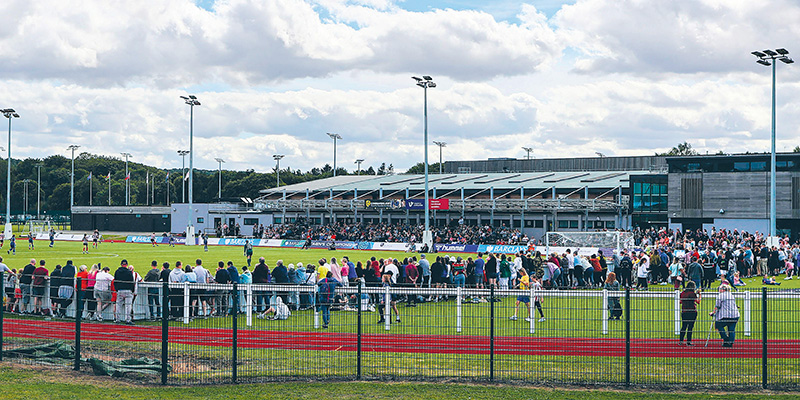
A sold-out Maiden Castle hosts Durham and Sunderland in the FA Women’s Championship earlier this season. Alamy
Interest has soared after England’s Euro 2022 win but, with only 12 teams in the top division, huge chunks of the country have no access to elite matches
By Jessy Parker Humphreys
31 October, 2022
There are not many places which can claim greater responsibility for the success of women’s football in England than the football pitches of Sunderland. Cast your eye out across them in the early 2000s and you might have seen a teenage Jill Scott practising against Carly Telford. A couple of age groups below you could have spotted Demi Stokes in the same side as Jordan Nobbs. By the mid-2000s, Lucy Staniforth and Lucy Bronze would have been playing in the school playground before heading to Sunderland training. A couple of years later, Beth Mead would make the move over from Middlesbrough to join an illustrious list of players from the north-east set to get England caps. When it came to England’s Euro 2022-winning squad, only Arsenal could lay claim to having developed as many players as Sunderland could.
Yet despite that legacy, the north-east has not had a top-flight WSL team since Sunderland’s application for a licence was rejected by the FA back in 2018. The side were forced to drop down two tiers, and were only promoted back to the second division last season. It is a familiar pattern across England where top-flight sides are clustered around London and the north-west – both areas have four. Of the remaining four teams, two are based in the Midlands, one on the south coast, and one in Berkshire.
So if you want to watch top-flight women’s football in London, you will be spoilt for choice. But if life has not plopped you down in one of only five specific parts of England, you might struggle. Not only that, if your daughter wants to play high-level football and you are not based in London or the north-west, she might find her opportunities much more limited than her peers in other parts of the country.
The reality is that, increasingly in women’s football, the teams that are top of the pile are the same as the ones in the men’s game. There is now only one remaining side in the WSL not supported by a Premier League club in Reading, and the top division of men’s football has a similar lack of geographic dispersion. With only 12 teams in the WSL, the spread is even smaller.
It is a hard balance for the FA. Clearly the Premier League sides have the financial heft to provide high-quality facilities and decent wages for their women’s teams in a way that sides lower down the pyramid just cannot. There are strict licensing requirements around stadiums and academy set-ups which also limit what kind of football team has the capability to actually compete at the highest levels of the game.
The FA have tried to come up with solutions, mainly through the locations of Lionesses games. The Stadium of Light played host to England’s World Cup qualifier against Austria while Elland Road (where Rachel Daly grew up) and Carrow Road (where Lauren Hemp did) have both also hosted recent England fixtures. There is certainly an awareness that hometown pride for the current players can be a big pull in terms of crowd size and deserves to be recognised.
There is also some hope that the general increased awareness and enthusiasm in women’s football will extend beyond just wanting to see England’s superstars. Women’s Championship and National League teams were reporting record crowds following the Euros. The WSL has long been seen as the be all and end all. At the very least, the lack of geographical dispersion should encourage the growth of a more vibrant national league structure as fans begin to seek out women’s football on their doorstep. The “if you build it, they will come” approach has propelled Durham to being one of the most successful independent women’s football clubs in the country.
Ultimately the problem remains that football is run by capital and capital has a tendency to concentrate itself in certain metropolitan areas. Much of the rhetoric around the growth of women’s football subtly aligns itself with the commandments of ever more marketing, advertising and endless money. Until the highest echelons of football can free themselves from that, there will continue to be inequality in the areas where the very best play.
The answer, then, is to continue to show up for whoever is your local team – men, women, both. Maintaining and developing a robust national pyramid is the best way to preserve the game. You never know which stars of the future you might get to spot on a pitch near you.
This article first appeared in WSC 426, November/December 2022. Subscribers get free access to the complete WSC digital archive
Want to see your writing published in WSC? Take a look at our pitching guide and get in touch
Tags: Durham, Sunderland, Women's Football, Women's National League, Women’s Championship, WSL
